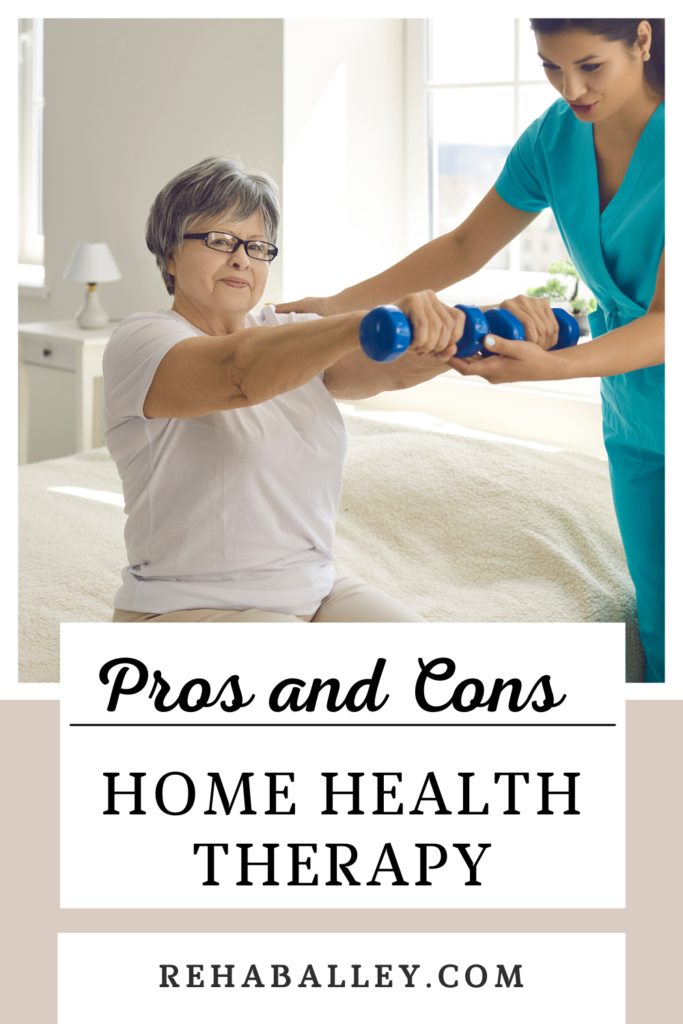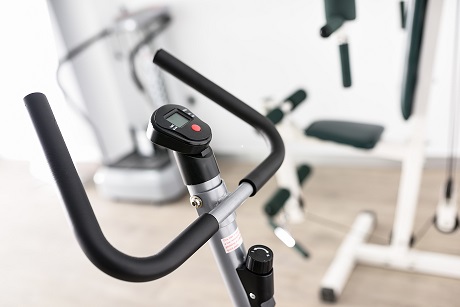Table of Contents
If you or someone you love are in need of therapy, you probably have done some research, and have questions about rehab for elderly after hospital stay. If you have read my blog The Top 5 Benefits of Inpatient Rehabilitation (LINK), You may have a clearer understanding of what to expect in an Inpatient Rehabilitation Facility. However, very few patients and families know of other options outside of the clinic and hospital setting.
If you or your loved one need additional care and are seeking other options, home health therapy may be a good option for you. In this article, I would like to discuss the top (3) pros and cons of home health therapy to help you make a better decision, but first, I would like to discuss just what home health therapy is.

Home health therapy is an option for patients who are eligible to receive therapy services: Physical Therapy, Occupational Therapy, and/or Speech Therapy, inside of their home. In most cases, patients can also receive nursing care and a case manager who typically oversees their overall care under a doctor’s orders.
One major qualifying factor in determining whether a patient is eligible to receive home health services is that they must be considered home-bound. Conditions that would qualify a patient as home-bound typically include:
- Needing assistance with all functional activities
- Requiring taxing effort to leave the home
- Being unable to safely leave the home unattended
- Having severe shortness of breath upon exertion
- Having residual weakness
- Having increasing confusion that prevents from leaving the home unattended.
A team of healthcare professionals will determine if a patient falls into one of these categories that may qualify them for home health services. Once an agreement has been made between the doctors, healthcare professionals, and the patients/family, then the doctor will write orders to initiate home health services. Other factors including the patient’s health coverage will also be considered.
Property of Rehaballey.com
After orders have been written, patients will be assigned to a home health agency (usually of their choice), and will soon receive a phone call from the recommended disciplines to schedule an evaluation at the patient’s place of residence. Each discipline will evaluate the patient’s needs, establish a plan for care.
In short, a plan for care will include a brief assessment of the patient’s needs, services to be rendered, how long services are to be rendered, and goals that will determine how a patient is progressing. If any issues arise, then the plan for care can be adjusted as needed.
**ALLEY TIPS: Remember you may be seen by multiple disciplines: therapy, nursing care, multiple times per week depending on each discipline’s plan for care**
Now that you have a brief background of what home health services are, let’s dive into my top (3) pros and cons of receiving home health services for therapy.
THE PROS
#1 PATIENTS GET TO REMAIN IN THEIR HOME ENVIRONMENT
I briefly touched on this concept in my home health blog to the clinicians. What I have found in my career as a physical therapist is that patients tend to do better mentally in their own home environment, and this often can reflect positively on their physical performance as well. This can be contributed to patients being in a familiar environment for which they can feel comfortable, and more in control.
Patients also have the added benefit of being around friends, family, and even pets more often which can help ease tension and anxiety about their current condition. By having more control of their environment, usually puts patients in a position where they can be more proactive about their care and therapy services. Not to mention, that patients are usually in a better mood about receiving therapy; which can have a positive impact on their progression and outcomes.
Property of Rehaballey.com
Therapists who work with patients in their homes have the benefit of incorporating the patient’s actual environment in the treatment sessions, which helps to make treatments more functional, realistic, and meaningful for the patients.
#2 PATIENTS GET TO SPEND ONE-ON-ONE TIME WITH THERAPIST

I also discussed this topic in my home health blog to the clinicians regarding the advantages of spending one-on-one time with patients.
One of these advantages is that fewer distractions and interruptions give the therapist more ability to provide high-quality care. More activities can be initiated and instructions can be provided, which makes the sessions more patient-focused. Patients generally feel overwhelmed when being interrupted by several different staff members, which often leads to feelings of disorganization and mistrust toward staff.
Not to mention that clinicians take a hit as well. One study shows that any interruption introduces a change in work patterns and often leads to more stress, higher workload, higher frustration, more time pressure, and effort.
#3 PATIENTS GET TO SCHEDULE AROUND THEIR DAY
Some patients that have stayed in a hospital can probably attest to the fact that hospitals can be a very hectic and fast-paced environment. Most of the time, clinicians are running a tight schedule, which oftentimes leaves patients scrambling to keep track. I had a patient one time; tell me about their typical day in the hospital.
He remembered being awakened by staff several times during the night for blood pressure checks, then at the very start of the day he had to scramble to eat breakfast, get dressed, and take a full cup of meds before preparing for his therapy session.
Once finished with therapy, he returned to the room to catch up on some sleep only to be interrupted by various doctors, nurses, and clinicians all seeking to obtain and/or provide information.
Now I’m not saying that hospitals can’t be beneficial, and those that have read my blog, The Top 5 Benefits of Inpatient Rehabilitation (LINK) know that it certainly can be. I’m simply saying that patients have the least control over their schedules in a hospital environment. Most of the time their schedules are centered around the demands of the hospital staff.
In contrast, a home health environment allows patients to have more stability and control of their schedules. For example, patients get the opportunity to choose the day and time that they would like to have therapy. They can schedule their therapy sessions around appointments, family, and other responsibilities as long as they can complete the recommended sessions each week.
Property of Rehaballey.com
THE CONS
#1 LESS ACCESS TO EQUIPMENT

This is perhaps one of the biggest cons that I hear from patients who have either gone through home health therapy in the past or have chosen not to go through with home health therapy.
The equipment in the home health care setting is very limited compared to the hospital. Most of the time therapists can only bring items that can fit in their backpacks, briefcases, or cars; and are usually limited to items such as resistance bands, cones, hand weights, small TENS units, etc.
In the hospital/clinic setting, patients get the opportunity to utilize more equipment and exercise machines in order to improve outcomes and progress toward independence. Examples of machines used include the Nustep Bike, Lite Gait, Bioness, Exoskeleton, and MotoMed just to name a few.
For those patients who are weaker and more dependent and need, extra assistance with transfers, equipment such as the Sera Steady, Tilt Table, and Hoyer Lift (LINK) are available to lessen the load off of the therapist making transfers and treatment sessions achievable and safer for patients.
#2 LESS INTENSE
This topic goes hand-in-hand with the previous topic mentioned. Since there is less equipment, the therapy sessions also tend to be less intense, despite the therapists’ efforts to utilize their limited resources. Patients also tend to have fewer sessions in a home health setting as compared to a hospital or clinic.
As mentioned in my blog The Top 5 Benefits of an Inpatient Rehabilitation (LINK), patients in a rehab setting are required to get 3 hours of therapy per day up to 5-6 times per week.
Since rehabs are so intense, patients are usually ready to discharge on average of about 2 weeks. In contrast, patients in a home health setting typically receive fewer sessions per week, and sessions typically last between 30-60 minutes. Patients in this setting will typically receive therapy for 1-2 months before discharge.
#3 DISCIPLINES NOT READILY AVAILABLE
The final con about home health therapy is that therapists and other home health staff are not readily available. Now, don’t get confused about home health and caregiver services. Caregivers are a separate entity from the home healthcare discussed in this blog.
Home healthcare discussed in this blog includes therapists, nurses, case managers, or doctors that are in charge of your care at home. Since home healthcare providers come and go, and are available at different times, it can be more difficult for patients to communicate their needs.
They also do not have healthcare providers readily available if concerns or emergencies were to arise. In contrast, if an emergency were to occur in a hospital setting, a team of healthcare providers ie: a rapid response team can arrive within minutes.
However, if help is needed at home, patients can always call their therapist or nurse if they have questions or need assistance. In the case of an emergency at home, always call 9-1-1 first.
It may sometimes be difficult for older adults, who live alone, to access a phone in the case of an emergency. For this reason, I recommend a medical alert device (LINK), which is a pendant worn either around the neck or somewhere on the body and has a button that immediately notifies a medical emergency team. I will give references to the medical alert device in future blogs and/or videos.
Those are my top (3) pros and cons for home healthcare therapy. This is definitely an option for those seeking alternatives to a traditional setting; I highly recommend exploring all possible options before making a final decision. GOD BLESS YOUR ENDEAVORS!!






It’s great that you pointed out how elderly rehab care would usually have the patients in a better mood about receiving therapy. My grandfather recently got discharged from the hospital but it seems he is still feeling some aftereffects from it. We want him to be well taken cared of, so we’re thinking of having professionals take care of him.
I’m glad you found this article helpful. Hopefully, your grandfather finds the help he needs at home.